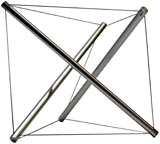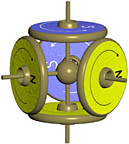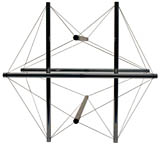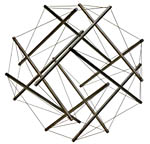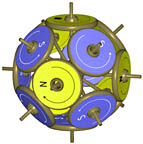Clockwise and counterclockwise rotation, a binary principle as well as a symmetry principle, can be seen in many ways in various structures. When the filaments in a weave pattern or the strut arrangement in a tensegrity structure are said to "rotate" it's clear they are actually sitting quite still. We are talking about only virtual motion. Even so, this helical tendency is translatable into real motion by transposing the static domains of tensegrity figures into actual wheels or gears. Shown here are three tensegrity structure examples along with sets of disk-shaped magnets. These spherical arrangements are born of the same geometry as the tension networks of the tensegrity structures.
As with the polyhedral magnet mosaics the disc magnets shown here have their north pole on one face and south on the other so that when they are edge-to-edge, checkerboarded with opposite poles facing out, they cling to one another. And because of their magnetic contact they can be made to revolve like gears.
The magnet structures are a part of my long-running, open-ended, artwork, "Portrait of an Atom". They also tell us that the world of structure and geometry is like a room of many mirrors endlessly reflecting similarities, relationships and numbers. In the case of the magnets, the directions the arrows point describe not only the rotation and counter-rotation of the gears but they also identify the direction that electrons would be moving if these were current electrical loops rather than permanent magnets, in order to produce north/south magnetic attraction. Though my atom model, “Portrait of an Atom” is speculative, the magnet relationships and their geometry are a fact of nature.
|
Three-strut tensegrity with five-magnet spherical gear set. The helix on the top and bottom triangles are counterclockwise; the edges are clockwise. These correspond to the alternating of magnets and wheel rotation in the spherical set of five magnets.
Six-strut tensegrity structure with an eight-magnet spherical gear set. The corner triangles of the six-strut figure are alternately clockwise and counterclockwise helixes.The eight-wheel spherical set also has alternating magnets that are checkerboarded around the sphere.
A twelve-strut tensegrity structure shown side-by-side of its counterpart, a spherical fourteen-magnet set. The sites for the magnets are identified with the twelve-strut form's eight trianglular corner triangles and six square faces. |
